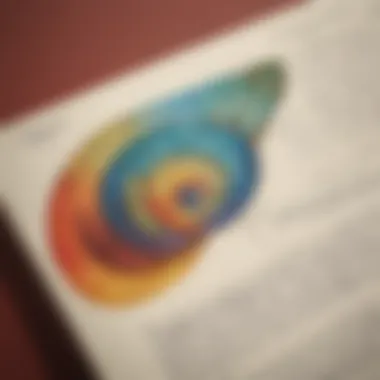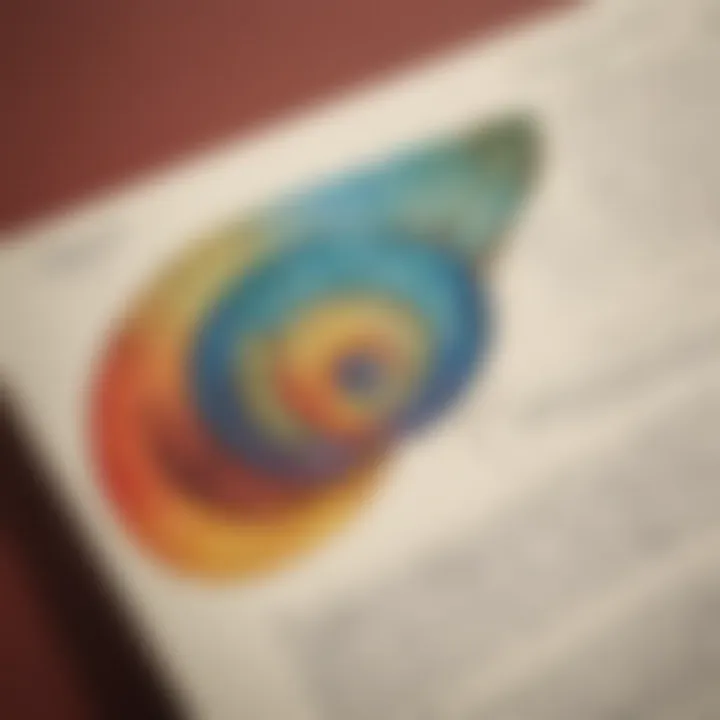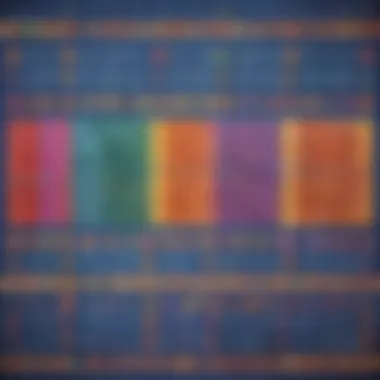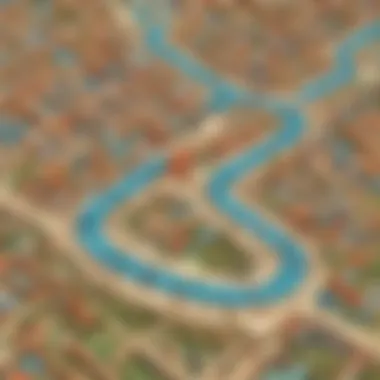Understanding and Solving Number Sequences in Mathematics


Intro
Understanding number sequences is crucial in mathematics. These sequences not only show patterns but also serve as essential tools for problem-solving. They appear in various contexts, ranging from everyday life to advanced mathematical theories. By exploring number sequences in a structured manner, students can develop logical reasoning skills needed in mathematics. This article aims to clarify ways to identifying these sequences, and how to find their solutions.
Creative Activities
Engaging kids in creative activities can significantly improve their understanding of number sequences. Here are some ideas:
Craft Ideas
- Sequence Beads: Use beads in different colors to represent numbers. Kids can create sequences by stringing the beads together, reinforcing the concept.
- Pattern Art: Have children create drawings using a sequence of shapes or colors. This reinforces recognition of sequences in a fun way.
Step-by-Step Guides
- Create Sequence Beads: Gather various colored beads and a string.
- Choose a pattern: Decide on a number sequence, for example, odd numbers or multiples of 3.
- String the beads according to the sequence. Discuss the logic behind the placement of each bead.
Educational Value
Engaging in these crafts can boost children's critical thinking. By creating and analyzing their patterns, they begin to recognize the logic in mathematics. This hands-on approach stems interest and can extend to more complex math themes.
Fun Quizzes
Quizzes are a great way to reinforce knowledge of number sequences.
Quiz Topics
- Understanding arithmetic sequences.
- Identifying geometric sequences.
- Recognizing the Fibonacci sequence.
Question Types
- Multiple Choice: Identify the next number in a pattern.
- Fill in the Blanks: Complete the sequence.
- True or False: Determine the validity of created sequences.
Knowledge Reinforcement
Quizzes can validate understanding. Children gain instant feedback, helping them learn from their mistakes. The combination of repetition and feedback solidifies their grasp of number sequences.
Fact-Based Articles
Reading fact-based articles also enriches their knowledge of number sequences.
Topics
- Applications of number sequences in real life.
- Historical significance of sequences in mathematics.
Engaging Content
Articles should not just provide facts, but also present them attractively. Using simple language helps elementary school students engage better. Interactive graphics or examples can further bolster comprehension.
Intro to Number Sequences
In the realm of mathematics, number sequences serve as a foundational concept that underpins various phenomena observed both in academic settings and real life. Sequence knowledge is not merely theoretical; it empowers young learners with critical thinking and logical skills necessary for tackling diverse mathematical challenges. Understanding these sequences prepares students for higher-level math and enables them to engage meaningfully with the world.
Definition of Number Sequences
A number sequence is essentially a list of numbers arranged in a specific order, following a particular rule or pattern. Sequences can be finite or infinite, depending on their defined end. Common types include arithmetic and geometric sequences, each possessing unique characteristics. For instance, an arithmetic sequence has a constant difference between its consecutive terms, while a geometric sequence follows a fixed ratio.
Such definitions help students grasp the structured nature of mathematics, encouraging better comprehension of subsequent topics.
Importance of Understanding Sequences
Understanding number sequences goes beyond the scope of solving math problems. Here are several vital reasons highlighting this importance:
- Foundation for Advanced Topics: Familiarity with sequences is crucial for tackling algebra, calculus, and advanced number theory.
- Logic Development: Working on sequences fosters logical reasoning and pattern recognition, pivotal skills in mathematical thinking.
- Problem-solving Skills: Engaging with different types of sequences hones students' ability to discern relevant information from a problem, significantly enhancing their analytical capabilities.
In summary, a firm grasp of number sequences lays the groundwork for success in math-related courses and everyday problem-solving scenarios.
By learning number sequences, students can unlock deeper patterns in mathematics and apply them to diverse fields such as science and economics.
Types of Number Sequences


Understanding number sequences begins with knowledge of their many forms. Number sequences can vary greatly, and recognizing type helps to discern patterns and strategies for solving them, which is valuable not just in learning, but also in everyday math applications. This section covers different categories of sequences, emphasizing their uniqueness, applicability, and importance.
Arithmetic Sequences
Definition and Characteristics
Arithmetic sequences are a class of numbers where the difference between consecutive terms remains constant. For example, in the sequence 2, 4, 6, 8, the common difference is 2. This consistency is essential, allowing for straightforward calculations when solving problems or creating formulas. One key advantage of this type is its simplicity, making it accessible and popular for early learners capturing the concepts of sequences.
Common Formulas
The main formula for an arithmetic sequence references the first term and the common difference. The n-th term can be calculated using the formula:
a_n = a_1 + (n - 1)d,
where a_1 represents the first term, d is the common difference, and n denotes the term position. This formula is benefits the learner as it provides a systematic approach to finding any term in the sequence. Its straightforward nature emphasizes quick and effective student learning.
Examples of Arithmetic Sequences
Recognizing examples of this kind of sequence reinforces understanding. For instance:
- 10, 15, 20, 25: Common difference is 5.
- 0, -3, -6, -9: Common difference is -3.
These examples show how arithmetic sequences appear in various contexts, enabling learners to grasp the concept easily. Though it offers many advantages including ease of understanding, realizing every term relies exclusively on its predecessor might seem limiting.
Geometric Sequences
Definition and Characteristics
Geometric sequences vary noticeably from their arithmetic counterparts. The ratio between consecutive terms is constant. For instance, in the sequence 3, 6, 12, 24, the ratio is 2. This characteristic leads to exponential growth or decay. It is beneficial when calculations involving percentage increases or compounding interest are crucially relevant.
Common Formulas
In geometric sequences, the calculation relies on the first term and the common ratio. The n-th term is defined by the formula:
a_n = a_1 imes r^(n - 1),
with a_1 being the first term, r as the common ratio. Such formula emphasizes versatility, allowing it you work with numerous real-life problems but also highlight calculations for students getting used to patterns.
Examples of Geometric Sequences
Examples illustrate the concept well:
- 5, 10, 20, 40: Here, the ratio is 2.
- 81, 27, 9: The ratio is 1/3.
Geometric sequences significantly appear in finances. Even though they illuminate positive aspects like steady growth patterns, realize the nature's dependence on the ratio alters by large graduations, possibly being unrestrained in multiplication.
Fibonacci Sequence
Definition and Characteristics
Perhaps the most famous sequence, the Fibonacci series uses a distinct rule: each term represents the sum of the two preceding ones. Starting from 0 and 1, the sequence is: 0, 1, 1, 2, 3, 5. This intrinsic association enables a seamless continuity which resonates throughout various applications. While especially useful in mathematics, its encouraging nature in art and nature brings remarkable value.
Applications in Nature
The Fibonacci sequence manifests prominently in natural occurrences. For example, the arrangement of leaves around a stem or the branching patterns of trees often reflect Fibonacci numbers. Such explorations point out the connection between mathematics and the natural world, fostering awe and curiosity. Grasping this dynamic encourages explorative and abstract thought among students in observing life outside math problems.
Calculating Fibonacci Numbers
The millions who use computational technology handle Fibonacci numbers via methods such as recursion. For example, consider calculating a specific Fibonacci number using recursive method
Using previous knowledge makes any term recognition forms a deeper understanding while offering flexibility neat for not wasting practicing material, even generating convergence themes.
Triangular Numbers
Definition and Characteristics
Triangular numbers form as a series of added integers. The first few triangles include 1, 3, 6, and 10. Recognizing such patterns aids learners in appreciating both visualization and computation of these arrangements. The emblematic trait reflects the notion of structures seen in geometry and number combination alike. Realizing how these intersect and build serves learners well.
Calculating Triangular Numbers
A formula defines triangular numbers clearly:
T_n = n(n + )/
This calculation streamlines finding the n-th triangular number without mismatch based uniformity inherent merit for foundational consequently enhancing calculation skill understanding while supporting conceptual growth.
Real-World Applications
Triangular numbers recur across assorted fields, like sports tournaments where positions are possible or certain pattern formations in design. Such associations cultivate understanding exciting emergent shape formations often enhancing deeper understanding about structures foster while viewing beauty around us in mathematics data. This affords learners insights that attract continuation to transcend mere formulas.
Understanding the types of number sequences solidifies mathematics, granting access to varied practical applications. Always strive to see numbers not as isolated concepts but interconnected ideas that tell a deeper story.


Identifying Patterns in Sequences
Recognizing structures within various number sequences is pivotal in this field of mathematics. Through the identification of patterns, learners develop a systematic approach to problem-solving that not only aids in finding specific solutions but establishes a solid foundation for further mathematical concepts. The ability to detect regularities enhances logical reasoning skills. This section explores several ways in which patterns in sequences manifest, helping students deepen their understanding of this fundamental concept.
Recognizing Common Differences
Common differences often appear in arithmetic sequences, formed by consistently adding or subtracting the same number. This uniformity makes it easier for students to predict subsequent numbers. For example, in a sequence such as 2, 5, 8, 11, and 14, the common difference is 3. Recognizing that this is a linear progression allows the learner to generate little calculations or find missing numbers quickly.
Here is a method to quickly identify common differences:
- Identify the first two numbers in the sequence.
- Subtract the first number from the second.
- Ensure the same difference persists by checking subsequent pairs.
Example:
In the sequence: 4, 7, 10, 13, and 16:
- Common difference = 7 - 4 = 3
- Check for other pairs:
- 10 - 7 = 3
- 13 - 10 = 3
- 16 - 13 = 3
This ensures the identification of a consistent rule that can help in further calculations about the series.
Multiplicative Patterns
Similar to common differences, multiplicative patterns arise in geometric sequences, where each term is obtained by multiplying the previous figure by a constant. Distinguishing these patterns is essential for complex mathematical problems. For example, in the series 3, 9, 27, each number is the product of the previous one and 3, which means the common ratio is also 3.
To determine if a sequence demonstrates multiplicative behavior, follow these steps:
- Take any number and divide it by the previous one.
- The quotient must remain constant throughout the series for it to be classified as geometric.
Example:
In the series: 2, 6, 18, 54:
- Check relationships:
- 6 / 2 = 3
- 18 / 6 = 3
- 54 / 18 = 3
This validates a common ratio of 3, allowing learners to proactively calculate future terms:
- Next term = 54 * 3 = 162
Combining Patterns
Some sequences engage both additive and multiplicative themes. For instance, one might encounter a sequence that begins with one rule before shifting to another argument. Recognizing situations where such transformations happen extends the learner's flexibility in approaches. Understanding how to combine these patterns inspires strategic thinking and encourages considerable observational skills.
With practice, students can identify sequences containing multiple influences, leading to richer mathematical understanding. Recognizing that constant shifts happen facilitates further exploration into more complex problems that arise in mathematics.
Through reflecting upon these strategies, it becomes possible to create not only a guidance plan for number sequences but also develop a generalized methodology. Handling the aforementioned patterns is not just formality but will propel a foundational understanding waiting to underpin much more advanced mathematical capabilities.
In summary, recognizing patterns plays a vital role in solving number sequences efficiently. Understanding these differences can enhance students’ critical thinking skills, making them effective problem solvers.
Methods for Solving Number Sequences
To dive into number sequences, one must know how to find solutions efficiently. The methods for solving number sequences are essential tools that support the entire learning process surround them. They serve as frameworks for understanding complex patterns and relationships in numbers.
Using effective methods can make the problem simpler and less anxiety-provoking. For example, they allow students to explore mathematical relationships more deeply. With various approaches at their disposal, learners can choose the one that best suits the specific problem they are tackling.
Moreover, using systematic methods promotes critical thinking. It aids in discovering unique solutions while also encouraging students to verify their reasoning. This skill is crucial as it fosters independence and self-confidence in solving a range of numerical problems.
Using Algebraic Equations
Algebraic equations are powerful allies in solving number sequences. They transform a sequence problem into a formulaic structure, which allows the alignment of terms clearly. For instance, if you have the sequence 2, 4, 6, you recognize adding 2 each time leads you to an equation:
n = 2 + (n-1) * 2
Here, n represents the nth term. By plugging in different values for n, one will swiftly reveal the next term in the sequence.
The ability to formulate equations is crucial not only for arithmetic and geometric sequences but for others as well, like Fibonacci or triangular numbers. Working with these equations grants insight into relationships existing within sequences. It allows for broader applications in solving more complex sequence patterns individually.
Applying Recursive Formulas


Recursive formulas employ previous terms from the sequences to establish subsequent numbers. This provides a unique perspective on sequences. Instead of focusing on a formula that directly reaches a term, you think about it as building from what you know.
A well-known example is th Fibonacci sequence. Its recursive formulation states that each term equals the sum of the two preceding terms. Expressed mathematically, you get:
F(n) = F(n-1) + F(n-2)
This Formula allows each term to be calculated based on its prior components. Applying recursive formulas is vital in algorithms and computers where progression depends on retaining prior values.
Utilizing Graphical Representations
Lastly, graphical representations are essential when solving sequences. Visual efficacy plays a role in numeracy comprehension. By plotting terms on a graph, one can witness patterns emerge organically. It visually substantiates ideas such as linear growth in arithmetic sequences or exponential growth in geometric sequences.
Creating graphs, such as line or bar charts, adds clarity to problem-solving methods. For instance, observing how the terms spread out can illuminate if a sequence is accelerating or decelerating. Unique behaviors become more manifest upon graphically representing data, guiding students towards insights they may miss in purely numerical formats. Those visual insights can guide analytical thinking and help verify the correctness of potential solutions.
Practical Examples and Exercises
This section emphasizes the role of practical examples and exercises in grasping number sequences. Seeing theory in action enhances retention. When learners engage with meaningful problems, the abstract concepts become concrete. This approach fosters deeper understanding, aiding both learners and their mentors in identifying where gaps in knowledge may exist.
Sample Problems with Solutions
Sample problems showcase applications of number sequences. Here, we value clear and straightforward questions. Each problem challenges young minds, inviting examination of different methods. Solutions are pivotal as they clarify thought processes and demonstrate effective problem-solving techniques.
Example 1:
Given the arithmetic sequence: 2, 5, 8, 11, __, __. Identify the next two numbers and explain your reasoning.
Solution: The difference between terms is uniform. Each number moves up by 3. Hence, continuing the pattern gives us 14 and 17.
Example 2:
Consider the Fibonacci sequence: 0, 1, 1, 2, 3, __, __. What are the next two numbers?
Solution: Each new term aggregates the previous two. Therefore, 5 and 8 follow.
Interactive Exercises for Practice
Interactive exercises cultivate engagement and allow active learning. These dynamic tasks can range from online platforms to hands-on manipulatives that promote exploration.
Here are some methods for interaction:
- Online Quizzes: Sites like Khan Academy offer instant feedback.
- Group Challenges: Foster teamwork. Children solve problems in pairs.
- Visual Representation: Using tools like Graphing Calculators can solidify comprehension of sequences through observation.
By leveraging these various methods, learners deepen their understanding. Engagement means more significant learning gains and encourages a curiosity that spans beyond the classroom.
Common Challenges in Sequence Problems
Understanding how to solve number sequences involves navigating various challenges. Recognizing these challenges is vital for avoiding common pitfalls that can hinder one's progress. Gathering awareness about potential problems allows learners to develop strategies for overcoming them, enhancing their math skills. The two significant challenges discussed here include misunderstanding sequence types and inadequate pattern recognition.
Misunderstanding Sequence Types
Misunderstanding sequence types is a frequent hurdle in solving number sequences. Given that there are multiple types of sequences—arithmetic, geometric, Fibonacci, and others—students may confuse their characteristics. For instance, students might apply an arithmetic approach to a geometric sequence, leading to incorrect conclusions.
- Key Characteristics: Each sequence has distinct characteristics. Arithmetic sequences have a constant difference, while geometric sequences exhibit a constant ratio. Learning these properties is fundamental for correct identification.
- Identifying Types: Encouraging students to familiarize themselves with various sequence types fosters awareness. They can better distinguish sequences by recognizing key features and practices.
This understanding lays the foundation for successful problem-solving in math, ensuring students can tackle diverse questions without Gridlock.
Although test questions may ring familiar, needing conceptual clarity on sequence types ensures a learner can build accurate responses promptly.
Inadequate Pattern Recognition
Inadequate pattern recognition is another common challenge affecting students as they work with sequences. Recognizing patterns is essential to solving sequences efficiently. Students who struggle to identify and analyze patterns often find themselves frustrated, unsure on how to continue when faced with number sequences.
- Character of Patterns: Patterns can be numerical, visual or even logical. Effective pattern identification leads learners to more powerful insights into the sequence at hand.
- Practice Methods: Engage in ample practice problems with a variety of patterns allows students to refine their their skills. By working through different sequences, learners will gradually improve their ability to discern patterns logically.
Ultimately, developing recognition skills is a process requiring continued effort. As they become more comfortable spotting patterns, problem-solving becomes a less daunting task.
Understanding the nature of these challenges equips students for success. With the right approaches, learners can decipher sequences—a foundational component of mathematics.
Culmination
Recap of Key Concepts
In summary, key concepts covered include:
- Types of Number Sequences: We explored arithmetic, geometric, Fibonacci, and triangular numbers, each with unique properties and applications.
- Identifying Patterns: Recognizing common differences and multiplicative patterns is essential for solving sequences efficiently.
- Solving Methods: Practical strategies such as using algebraic equations and recursive formulas were addressed.
- Practical Examples: Engaging sample problems allow for hands-on practice, reinforcing theoretical knowledge.
Recapping these aspects enables clear retention of knowledge. By reviewing the different types and characteristics of sequences, along with effective solving techniques, students can fortify their understanding.
Encouragement for Further Exploration
Mathematics offers perpetual avenues for exploration. The realm of number sequences beckons one to delve deeper—the insights during practice lay a strong foundation for more advanced topics.
Learning does not stop here. Pursuing advanced concepts such as series or combinatorial sequences may enrich the mathematical journey. Continuously seeking new patterns is rewarding. Using resources such as Wikipedia, Britannica, and forums like Reddit can expand understanding.
This article wishes you all success in future learning endeavors. The thrill of uncovering new numerical relationships is remarkable—keep exploring.







